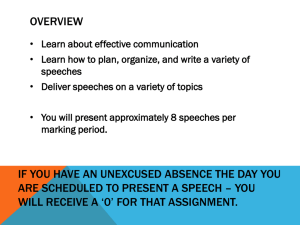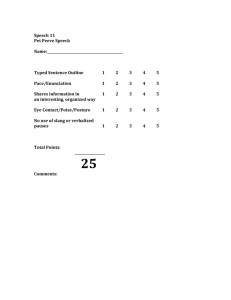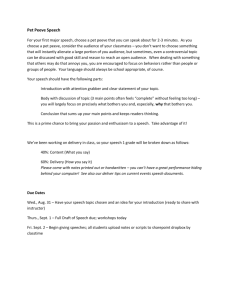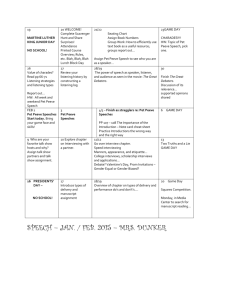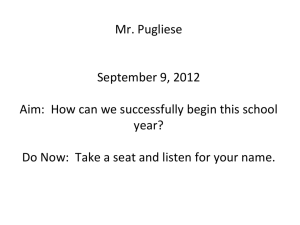Prepare a 30 second speech introducing yourself to the class and
advertisement
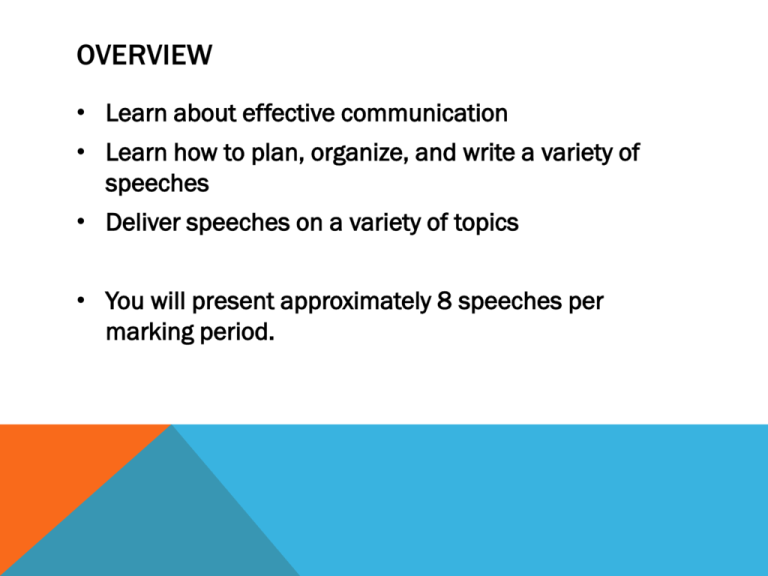
OVERVIEW • Learn about effective communication • Learn how to plan, organize, and write a variety of speeches • Deliver speeches on a variety of topics • You will present approximately 8 speeches per marking period. FIRST SPEECH ASSIGNMENT… • Prepare a 30 second speech introducing yourself to the class and explaining your reasons for taking Public Speaking. Speeches will be presented on Thursday!!! HOW TO PLAN A SPEECH • Grabber – begin with a strong statement or question that will make your audience interested in what you have to say. • Body – organize your speech logically. • Closing – end with a strong statement that brings your speech to a close. End on a high note. DIFFERENT SETTINGS FOR COMMUNICATION Informal: most of our comm. occurs in informal settings, which are casual, unstructured situations. Comm. is usually spontaneous [you think about what to say as you go along, and then you say it]. Examples: Formal: situations you can prepare for ahead of time These situations allow you to affect the ideas and feelings of people in important positions. Examples: COMMUNICATION Communication the process of sharing information by using symbols to send and receive messages. We will mainly be discussing interpersonal communication (between two or more people). Message: the ideas and feelings that make up the content of communication. MESSAGE Verbal and Nonverbal SENDER The Communication Process FEEDBACK Verbal and Nonverbal RECEIVER TYPES OF COMMUNICATION: 1. One on one- two people having a conversation. Examples? 2. Group- involves three or more people for a common purpose. Purposes? Examples? 3. Public- one or more people communicate with an audience. This is necessarily more formal. Examples? 4. Mass media—one person or perhaps several senders communicate with a large number of listeners. Usually these listeners are not physically present when the sending takes place so the receiver can “turn off” the sender at will. Examples? YOUR AUDIENCE To be an effective communicator, you must adapt to the needs of your audience. In formal situations, learn something about them before giving the speech. In informal situations/settings, you learn about them as you communicate w/ them. What to look for… Individual characteristics – personality, aspirations, interests; can help predict response to certain info Cultural characteristics – age, religion, national and ethnic background; can focus your presentation in such a way that the audience will understand and respond favorably to your message. Sociological characteristics – affiliations, educational background, and occupations; can formulate general ideas about your listeners. Speech Communication getting the meaning of thoughts one person has in his or her mind into the mind of another as clearly and accurately as possible by transmitting words with voices. To do so successfully, you must decide how to send and interpret messages. Encoding: The process of turning ideas and feelings into verbal and nonverbal symbols. Decoding: finding the meaning of verbal and nonverbal symbols. PREPARING A SPEECH I. Introduction Attention getter State your topic Give your viewpoint II. Discussion/Body Organize main points Personalize your speech Use vivid language III. Conclusion Indicate the end of the speech (cue your ending) Summarize Leave a lasting impression WAYS TO DELIVER A SPEECH Manuscript method: write down everything you plan to say, then bring your manuscript to the podium and read to the audience. Memorization method: begins with a written manuscript, but differs in that the manuscript is memorized and not used during the delivery. Extemporaneous method: speakers prepare outlines of the ideas of their speeches beforehand, but do not memorize an exact pattern of words. Outlines or note cards may be used. Impromptu method: when people must speak “off the cuff” with no preparation time. PREPARE A 30 SECOND SPEECH INTRODUCING YOURSELF TO THE CLASS. DO NOT SIMPLY TELL YOUR WHOLE LIFE STORY. FOCUS ON ONE OR TWO INTERESTING ASPECTS OF YOUR LIFE. YOUR GOAL IS TO MAKE YOUR SPEECH INTERESTING AND MEMORABLE. SPEECHES WILL BE PRESENTED THURSDAY!!! Aim: How can we analyze different types of communication? Do Now: define communication? 2/5/14 HW: Prepare a 30 second speech introducing yourself to the class and explaining your reasons for taking Public Speaking. Speeches will be presented TOMORROW!!! 2/6/14 AIM: HOW CAN WE EFFECTIVELY PRESENT OUR INTRODUCTION SPEECHES? DO NOW: LOOK OVER YOUR SPEECH. SPEECHES WILL BEGIN IN 5 MINUTES. HW: WHAT ARE SOME OF YOUR PET PEEVES? WHAT ANNOYS YOU? WHILE SPEECHES ARE BEING PRESENTED… • Be respectful. Your participation part of your grade will be determined by your ability to be a respectful audience. • Take notes on common mistakes being made. No specific names. • Take notes on the good aspects of the speeches. 2/7/14 Aim: How can we prepare a speech about a pet peeve? Do Now: What are 3 of your biggest pet peeves? Why? HW: Pet Peeve Speech due on Tuesday!!! PET PEEVE SPEECH • You must speak for at least 45 seconds in length. • Choose a pet peeve – something that really annoys, irritates, bothers you. • Can be something that many people experience or something that is specific to you. • Explain what the pet peeve is. • What specifically annoys, bothers, irritates you? • Why does this annoy, bother, irritate you? • How do you deal with it? Ignore? Take action? Ect. • You will have this week in class to work on your speech. • Presentations will be on Tuesday, 2/11 • You must hand in your written speech after you deliver your speech. I. Introduction Attention getter State your topic Give your viewpoint II. Discussion/Body Organize main points Personalize your speech Use vivid language III. Conclusion Indicate the end of the speech (cue your ending) Summarize Leave a lasting impression After you present your speech, you must hand in a copy of your speech. Pet Peeve Speech Speech must be at least 45 seconds in length. Speeches will begin on Tuesday.
